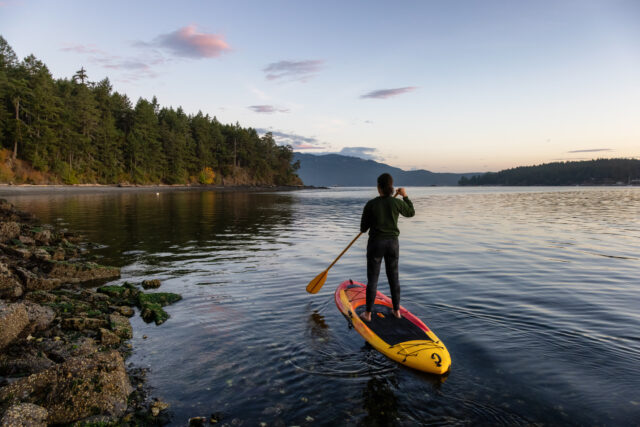But personally, my summer activity of choice is one that looks a lot harder than it actually is, and offers the perfect balance of exercise and relaxation: stand-up paddleboarding.
Despite my paddleboarding evangelism, I can’t tell you how many times I’ve had friends resist the offer to try because they fear their balance isn’t good enough. While it’s possible you’ll fall off your first few tries—not the worst thing on a hot summer day—with the right guidance, stand-up paddleboarding is easy to learn, and comes with a whole host of benefits. You get a full-body balance and stability challenge, plus a core, glute, and arm workout. Not to mention that blissful feeling of gliding across the water.
“Anyone can do it,” says Curt Devoir, director of the Professional Stand Up Paddle Association. “You don’t even need to stand—a lot of people just sit or kneel.” Plus, the sport is highly versatile—depending on your preference and comfort level, you could putter around a pond, catch some waves in the ocean, do yoga, or even race on a paddleboard.
Ready to get started? Here are some tips to know before you hop on board.
1. Learn from a expert
The best way to learn to paddle is to let a pro teach you, says Devoir. If you try to teach yourself, you could unknowingly introduce bad habits that are hard to break, he says.
You can find introductory classes nearly everywhere there’s a rental shop, most of which will provide the boards as part of the class. If you have the choice, opt to learn in a calmer body of water (like a lake or pond) before taking on the challenge of navigating the ocean’s waves. (But plenty of beginners learn in the ocean, says Devoir—just know that you may not actually stand all the way up, which is totally normal.)
2. Start on land
Before you hit the water, take some time to get acquainted with your equipment on land, says Devoir. You’ll want to test out your life jacket and leash, and adjust your paddle to make sure it’s the right height: If you put your arm straight up in the air and place the paddle on the ground in front of you, the handle should come up to your wrist.
Practice your hand placement. When your paddle is to the right of your board, your left hand should be holding the handle of the paddle, and your right hand should hold on midway down. When you switch to paddle to the left of your board, your hands also switch. (If you’re going to be paddling while sitting down or kneeling, you’ll want to take a lower grip.)
You can even do a full dry run. Stand in the middle of your board with slightly bent knees and one foot on either side of the carrying handle (your feet should be around hip-width apart, but try a wider stance if that makes you feel more stable), and try paddling through the air, switching your paddle back and forth between hands, and transitioning from standing to kneeling and back again without losing your paddle.
3. Stand up slowly
Actually getting to a standing position may be the toughest part of paddleboarding. But that shouldn’t be your first step: Get comfortable paddling around on your knees first, says Devoir, especially if you’re in the ocean.
When you do feel ready to stand up, take your time, suggests Candace Young, DPT, SCS, CSCS, a physical therapist at the Hospital for Special Surgery in New York City. Though you’ll want to get your feet planted quickly so you aren’t in limbo, keep your center of gravity low in a squat until you feel balanced, then rise all the way up. (Still keeping a soft bend in your knees, which will help you balance.)
One common mistake to avoid: Sticking your paddle out horizontally in front of you once you stand up, which Devoir says won’t actually help you balance. Instead, go ahead and stick the blade of the paddle in the water. “It adds some stability,” he says. “It’s like a third leg out there.”
4. Get moving
Just like it’s hard to balance on a bike that isn’t going anywhere, you’ll have an easier time staying steady once you actually start moving, says Devoir. For your most efficient paddling stroke, “you don’t want to pet the water,” he says. “Putting in just a couple inches of the paddle, you’re not going to get anywhere.” Instead, “reach forward, bury the paddle in the water, and pull it back, keeping the paddle as vertical as possible,” he says. Once the paddle gets back to your legs, pull it out of the water and start again.
The conditions and where exactly you’re trying to go will dictate how many strokes you do on one side before switching, but you should generally avoid switching after every stroke for efficiency’s sake.
Time to turn around? You can either stick your paddle way out in front of you, then sweep it around in a circle, or plant it behind you and push forward. As you get more comfortable, leaning into one foot or the other can help you steer, too.
And if you’re trying to stay vertical in the ocean, you may want to start out either facing the incoming waves or away from them, rather than having them hit your side, which will be a bigger balance challenge.
5. Relax your feet
When you’re feeling off-balance, it’s only natural to want to grip the board with your toes. Avoid this urge, says Devoir. “After a few minutes, you’re going to start to cramp up and your feet are going to hurt,” he says. Instead, try to relax your feet and spread out your toes. Your weight should be evenly distributed throughout your feet, says Young.
6. Don’t look down
“A lot of times, when people first get standing, they’ll look down and end up with this hinge in their torso,” says Young. “If you start to look down, your whole center of gravity starts to lean forward, and you’re not gonna stay on the board long after that.” Keep your chin and chest up, your eyes on the horizon, and your shoulders stacked above your hips.
7. Use your whole body
Though it may seem like your arms are working hardest when stand-up paddleboarding, it should be a true full-body sport, says Devoir. In other words, “if only your arms are sore, you didn’t do it right,” he says. “I’ll have days where I’m going upwind, and I’m using my legs more than my arms because you can get more power out of them.”
Paddleboarding should be fun, so don’t worry about whether you’re engaging the right muscles while you’re out there, says Young. As long as you maintain a slight bend in your knees, your quads and core should be turning on to help you balance.
Looking to up your paddling game with cross-training? Young suggests alternating reverse lunges, “so you have that strength to be able to push up from the board,” as well as squats, and planks, “to be able to keep that straight line from head to toe, which is what you want as you’re paddleboarding,” plus any balance exercise that has you practicing standing on one leg.











